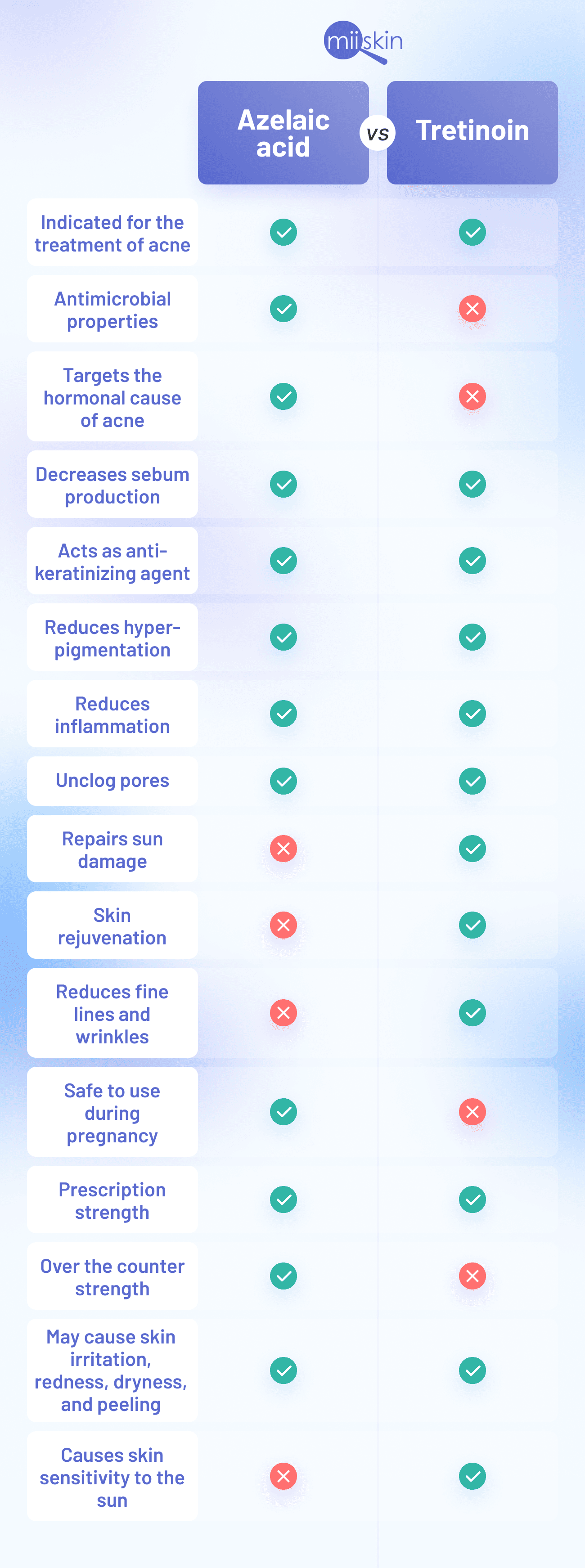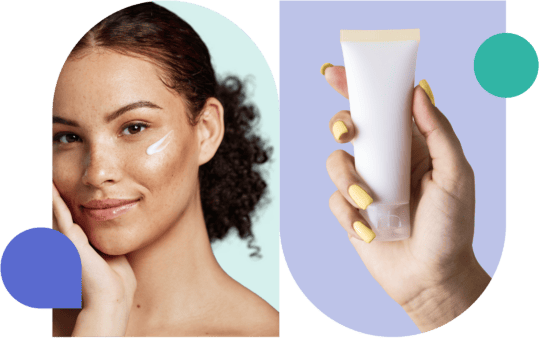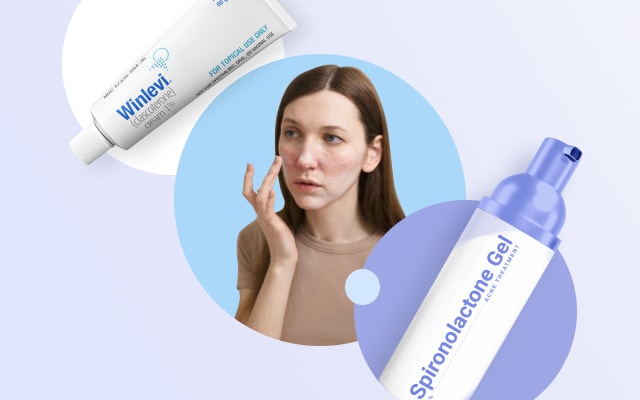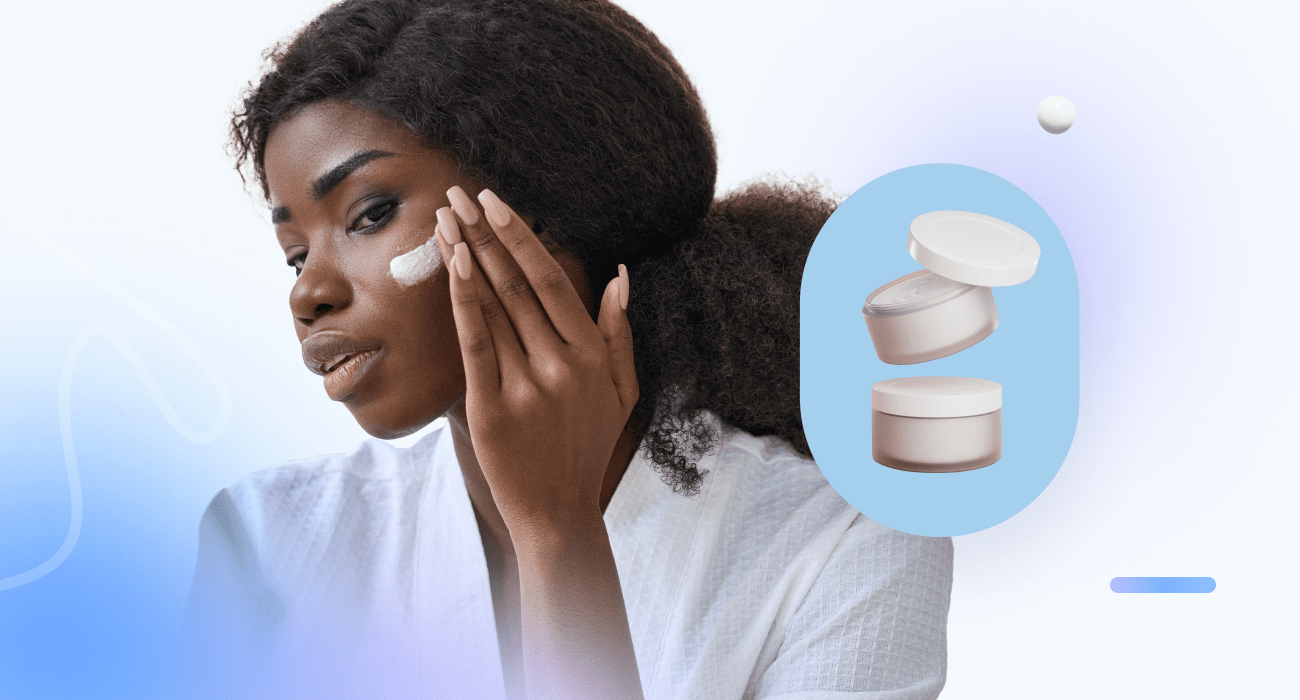Tretinoin vs azelaic acid: How to use together for acne & hyperpigmentation
Azelaic acid (Finacea) and tretinoin complement each other’s benefits, targeting acne, hyperpigmentation, and signs of aging for enhanced skin improvement. Read on to learn how to get the best out of this combination.
Table of Content:
Do you need a prescription? | Is a combined formula better? | How to get a customized formula? | Can you use them as two separate products? | How to use them together? | What not to do | Differences and similarities | About azelaic acid | About tretinoin
Our commitment to producing high-quality content:
The information presented in this article is based on scientific research and the professional advice of our Content Medical Reviewers, who are experts in the field of Dermatology. How we write our content →
Dr. Alpana Mohta, board-certified dermatologist, says that when it comes to tackling stubborn acne, post-inflammatory hyperpigmentation, or uneven skin tone, two of the most dermatologist-recommended ingredients are tretinoin and azelaic acid. Both are clinically proven to improve skin texture and discoloration, but they work in different ways.
Tretinoin, a prescription retinoid, speeds up cell turnover to prevent clogged pores and fade dark spots, while azelaic acid gently targets inflammation, redness, and pigmentation. But do you have to choose between them, or can you combine the two for even better results?
In this guide, we’ll break down how tretinoin and azelaic acid compare, their unique benefits, possible side effects, and—most importantly—how to safely use them together in a skincare routine for clearer, brighter skin.
Do you need a prescription to buy tretinoin and azelaic acid?
Dr. Mohta says you typically need a prescription to buy tretinoin. Azelaic acid, on the other hand, is available in both prescription and over-the-counter forms. For example you can buy Azelaic acid 10% OTC while azelaic acid 15% and azelaic acid 20% require a prescription.
Is it better to get a combined formula with tretinoin and azelaic acid?
Dr. Mohta says that a combined formula with tretinoin and azelaic acid can be a great option for people dealing with acne, hyperpigmentation, or melasma, since it simplifies the routine and ensures the two ingredients are balanced in dermatologist-approved concentrations. This reduces the risk of irritation compared to layering separate products, and makes it easier to stay consistent. Many compounded formulas also include soothing ingredients like hyaluronic acid, or ceramides, which help calm redness, boost hydration, and protect the skin barrier—making the treatment more tolerable.
How to get a customized formula of tretinoin and azelaic acid?
You can get a customized formula with tretinoin and azelaic acid through Miiskin, where a board-certified dermatologist evaluates your skin online and prescribes a tailored treatment if appropriate. The dermatologist can adjust the strengths of tretinoin and azelaic acid to suit your skin’s needs, and the compounding pharmacy may also include soothing ingredients like niacinamide or hyaluronic acid to make the formula more tolerable. This way, you can purchase from a mail-order pharmacy a dermatologist-guided, personalized treatment for acne, hyperpigmentation, or melasma—delivered conveniently to your door after you receive your prescription.
Can you use tretinoin and azelaic acid as two separate products?
According to Dr. Mohta, you can safely use tretinoin and azelaic acid as two separate products, but it’s important to be cautious since both can cause irritation, especially when you’re just starting out. The best approach is to introduce them gradually, applying each only 1–2 times per week and alternating them on different nights. Always pair them with a gentle cleanser, a nourishing moisturizer, and daily sunscreen to protect your skin barrier. Once your skin builds tolerance, you may use azelaic acid in the morning and tretinoin at night for maximum benefit. However, if you have sensitive skin or conditions such as rosacea, it’s essential to get personalized guidance from a dermatologist before combining them.
How to use tretinoin and azelaic acid together?
Skincare routine with tretinoin and azelaic acid
Morning (AM):
- Use a gentle cleanser
- Apply a thin layer of azelaic acid (2 times per week, on alternate days to tretinoin)
- Apply a with broad-spectrum sunscreen (SPF 50+)
Evening (PM):
- Use a gentle cleanser
- Apply a pea-sized amount of tretinoin (start with 1–2 nights per week)
- Follow with a moisturizer (or use the “sandwich method” by applying moisturizer before and after tretinoin if skin is sensitive)
Dermatologist Tips:
- Start slowly and alternate tretinoin and azelaic acid on different days/nights to reduce irritation.
- Increase frequency gradually as your skin builds tolerance.
- Daily sunscreen and a moisturizer is essential since both ingredients increase sun sensitivity and may cause irritation.
What not to do when using tretinoin and azelaic acid
❌ Don’t combine with other strong actives (like benzoyl peroxide or high-strength AHAs)
❌ Don’t start both products every day — introduce them slowly to avoid irritation.
❌ Don’t apply them on damp skin, as this can increase irritation.
❌ Don’t use large amounts — a pea-sized amount of tretinoin and a thin layer of azelaic acid are enough.
❌ Don’t skip moisturizer — both actives can be drying, so barrier support is essential.
❌ Don’t forget sunscreen — UV exposure can worsen irritation and undo progress.
Azelaic acid and tretinoin: Differences and similarities

What is azelaic acid and what is it used for?
Azelaic acid is a topical medication in the form of creams, gels, or foams that is primarily used for the treatment of acne, rosacea and hyperpigmentation3.
Azelaic acid needs a prescription for higher concentrations and can be bought over the counter for lower concentrations.
Benefits of azelaic acid
Azelaic acid, a naturally occurring dicarboxylic acid, is a potent antimicrobial against acne-causing bacteria, it is comedolytic, and it has anti-inflammatory properties that help reduce redness and swelling associated with acne4. It also aids in the normalization of keratinization, preventing the blockage of pores that often contributes to acne development.
- Antimicrobial effect: Azelaic acid has the ability to inhibit the growth and reproduction of acne-causing bacteria5.
- Regulates sebum production: Azelaic acid has been shown to inhibit the enzyme responsible for converting testosterone to dihydrotestosterone (DHT). By inhibiting its production, azelaic acid may help reduce sebum levels6.
- Helps target hormonal causes of acne: In a similar fashion to Winlevi, azelaic acid also blocks the activity of 5 alpha-reductase, an enzyme that converts testosterone into dihydrotestosterone (DHT)7. High levels of DHT are associated with increased sebum production and the development of acne8. By inhibiting this conversion, azelaic acid helps to reduce the effects of androgens on sebum production, helping to manage acne symptoms9.
- Helps to prevent the excessive buildup of keratin: Overproduction of keratin, a protein naturally found in the skin, can contribute to the formation of clogged pores and skin blemishes. Azelaic acid helps slow down the excessive growth of keratinocytes which can promote healthier skin and improve conditions like acne and hyperpigmentation10.
- Reduces hyperpigmentation: Azelaic acid inhibits the activity of tyrosinase (an enzyme involved in the production of melanin, which is responsible for skin pigmentation) and other oxidoreductase enzymes11.
Common side-effects of azelaic acid
- Skin irritation/rash
- Burning
- Dryness
- Redness
- Peeling
- Stinging
- Swelling12
Precautions and warning when using azelaic acid
Be aware that hypopigmentation (a lightening of the skin) may occur while using this medicine. If you have dark skin, use caution.
This medicine is considered safe to use during pregnancy and lactation, however it has the potential to cause allergic reactions. If you experience itching skin, trouble breathing, or large, hive-like swelling on any parts of your body, seek immediate medical attention.
It is important that you have regular visits with your doctor to monitor any potential side effects of this medicine. If your acne does not improve within four weeks, or if it worsens, make sure to check with your doctor.
If you do not see your rosacea improvement within 12 weeks, or if it gets worse, consult your doctor13.
What is tretinoin and what is it used for?
Tretinoin, also known as all-trans retinoic acid, is a topical medication that belongs to the class of retinoids. It is derived from vitamin A and is commonly used in dermatology for the treatment of acne, photoaging, fine lines, wrinkles and face roughness14.
Tretinoin is available in different formulations such as creams, gels, and lotions. To help you and your dermatologist in determining which formulation may be more suitable to address your particular skin condition, understand the differences between tretinoin cream and gel, their special qualities, and the various brands available.
Benefits of tretinoin
Tretinoin is widely used in dermatology due to its well-established efficacy and versatility in treating various skin conditions. However, tretinoin is a prescription medication and should only be used under the guidance of a healthcare professional.
- Promotes skin rejuvenation: Tretinoin promotes the turnover of skin cells and stimulates collagen production. This can lead to smoother skin texture, improved fine lines and wrinkles, and a more youthful appearance15.
- Reduces hyperpigmentation: Tretinoin can help fade dark spots and hyperpigmentation caused by sun damage, acne scars, or other skin conditions. It promotes the shedding of pigmented cells and encourages the growth of new, evenly pigmented cells16.
- Repairs sun damage: Tretinoin can help repair some of the damage caused by long-term sun exposure. It encourages the shedding of damaged skin cells and stimulates the production of new, healthier cells17.
- Regulates sebum production: Tretinoin helps to normalize sebum production by influencing the activity of sebaceous glands and reducing the production of excess sebum. Excessive sebum is linked to the development of acne, by regulating this, tretinoin can help manage acne and promote clearer skin18.
- Reduces acne scarring and improves overall skin appearance: Clinical assessment showed that regular use of tretinoin shows improvements in acne scars, pore size, skin moisture, vascularization, and skin firmness and elasticity19.
Common side-effects of tretinoin
- Burning/stinging
- Itching
- Skin peeling of the skin
- Lightening or darkening of the skin
- Redness
- Unusual dryness
- Warm sensation20
Precautions and warning when using tretinoin
Always follow the instructions given by your doctor. According to Dr. Mohta, during the first few weeks, you may experience skin irritation and temporary worsening of acne, known as the tretinoin purge. It may take up to 12 weeks to see significant improvement. If your skin becomes very irritated, consider switching to Altreno and if you don’t notice any improvement within 8 to 12 weeks, consult your doctor.
Tretinoin cannot be used by children under 12 years of age, pregnant or nursing women. Women should use contraception when using tretinoin as it is considered teratogenic.
Do not use any other topical products in the same area as tretinoin one hour before or after application, unless specifically instructed by your doctor. Using incompatible products may reduce the effectiveness of tretinoin or cause skin irritation.
Protect the treated areas from excessive sun exposure, wind, and cold weather. Your skin may become more sensitive and prone to sunburn, dryness, or irritation, especially during the first few weeks. Remember to apply sunscreen with SPF 50 every morning and reply when outdoors. Wear protective clothing and hats, and apply moisturizers or creams frequently.
Lee este artículo en Español: Ácido azelaico y tretinoína ¿Para qué sirven?
References:
https://pubmed.ncbi.nlm.nih.gov/2534550/
https://www.ncbi.nlm.nih.gov/pmc/articles/PMC3225141/
https://pubmed.ncbi.nlm.nih.gov/1712709/
https://www.sciencedirect.com/topics/neuroscience/azelaic-acid
https://pubmed.ncbi.nlm.nih.gov/2534550/
https://jddonline.com/articles/azelaic-acid-evidence-based-update-on-mechanism-of-action-and-clinical-application-S1545961615P0964X
https://www.ncbi.nlm.nih.gov/pmc/articles/PMC3969667/
https://jddonline.com/articles/azelaic-acid-evidence-based-update-on-mechanism-of-action-and-clinical-application-S1545961615P0964X
https://www.mayoclinic.org/drugs-supplements/azelaic-acid-topical-route/side-effects/drg-20062084
https://www.ncbi.nlm.nih.gov/books/NBK557478/
https://www.ncbi.nlm.nih.gov/pmc/articles/PMC6791161/
https://pubmed.ncbi.nlm.nih.gov/9774029/
https://www.ncbi.nlm.nih.gov/pmc/articles/PMC3225141/
https://pubmed.ncbi.nlm.nih.gov/15075042/
https://www.mayoclinic.org/drugs-supplements/tretinoin-topical-route/side-effects/drg-20066521






 Get a customized prescription!
Get a customized prescription!